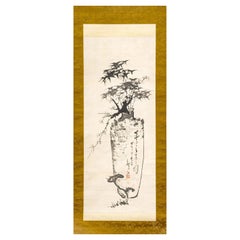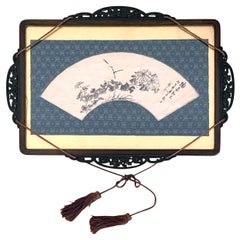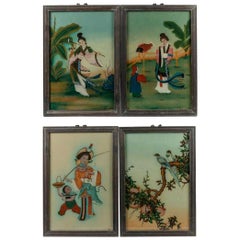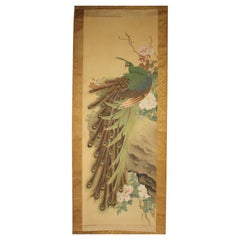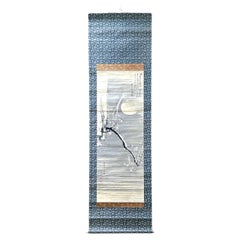Hidaka Tetsuo Furniture
to
2
2
2
2
2
1
1
2
2
2
2
2
2
2
12,342
3,863
2,489
2,227
Creator: Hidaka Tetsuo
Antique Japanese Ink Hanging Scroll Hidaka Tetsuo with Wood Storage Box
By Hidaka Tetsuo
Located in Atlanta, GA
A hanging ink (Sumi-e) silk scroll by Japanese Zen artist Hidaka Tetsuo (1791-1871). Well presented in brocade boarders and mounted on paperback, this scroll depicts "Three Noble Friends in Winter" in a poetic and novel way. One of the favorite subjects by Chinese painters, the three noble friends in winter consists of pine, bamboo and plum flowers. They were admired for their characters of strength in cold resistance to remain evergreen and even blossom in unfavorable condition. The artist, however, composited the subjects in a none-conventional way as Ikebana. Bamboo and flowering plum branches were presented in an oversized pot...
Category
19th Century Japanese Japonisme Antique Hidaka Tetsuo Furniture
Materials
Brocade, Wood, Paper
Framed Japanese Ink Painting Hidaka Tetsuo
By Hidaka Tetsuo
Located in Atlanta, GA
An ink painting on the fan surface by Japanese Zen artist Hidaka Tetsuo (1791-1871), now framed in a traditional Japanese carved wood frame with silk fabric mat and decorative hangin...
Category
1850s Japanese Japonisme Antique Hidaka Tetsuo Furniture
Materials
Wood, Paper
Related Items
Set of Four Japanese Reverse Paintings
Located in Locust Valley, NY
Set of four Japanese reverse paintings.
Category
Early 20th Century Japanese Hidaka Tetsuo Furniture
Materials
Glass
K29 Japanese Antiques A hanging scroll, Peacock on silk
Located in Niiza, JP
Silk, Scroll head: wood
Image size: 500(W) x 1450(H) [mm]
Scroll mounting: 650(W) x 2100(H) [mm]
Box size: 85×80×730㎜ 1100g
Estimated packing size: 130(W) x 130(H) x 800(D) [mm] 4kg...
Category
20th Century Japanese Hidaka Tetsuo Furniture
Materials
Fabric, Silk
K23 Japanese Antiques A hanging scroll, Dragon & Clouds Ink on Silk painted
Located in Niiza, JP
Ink on Silk, Scroll head: wood
Image size: 310(W) x 920(H) [mm]
Scroll mounting: 420(W) x 1750(H) [mm]
Box size: 70(W) x 70(H) x 520(D) [mm] 600g
Estimated packing size: 130(W) x 130...
Category
19th Century Japanese Antique Hidaka Tetsuo Furniture
Materials
Fabric, Silk, Wood
$650
H 68.9 in W 16.54 in D 1.19 in
19th Century Japanese Shunga Hand-Scroll, Katsukawa School
Located in Kyoto, JP
Shunga
Unknown artist
Meiji era, circa 1880
Hand-scroll mounted with 12 paintings
Ink, pigment and gofun on silk
Dimensions:
Each image measures H. 23.2 cm x W. 34.4 cm (9.15” x 13.5”)
The hand-scroll measures H. 28 cm x W. 540 cm (11” x 212”)
A set of 12 late 19th century Japanese Shunga paintings mounted as a hand-scroll. Two of the leaves bear the signature and seal ‘Setsuzan’, although we are unable to confirm the identity of the artist using this art name. 6 of the 12 images are taken almost directly from Katsukawa Shuncho’s late 18th century woodblock series, ‘Erotic Pictures...
Category
Late 19th Century Japanese Meiji Antique Hidaka Tetsuo Furniture
Materials
Silk
K2 Japanese Antiques Hanging scroll, Pine and crane, silk
Located in Niiza, JP
Silk, scroll tip: resin
Size: Image size: 370 (W) x 1200 (H) [mm]
All : 500 (W) x 1930 (H) [mm]
Box size: 80 x 80 x 580 mm, 800g Tomo-bako(Original box)
Pine and crane, a Japanese...
Category
20th Century Japanese Hidaka Tetsuo Furniture
Materials
Silk
Japanese Painting, Hanging Scroll, 19th Century Bamboo in Moonlight
Located in Kyoto, JP
Bamboo in moonlight
Gamo Rakan (1784-1866)
Hanging scroll, ink on silk.
Dimensions:
Scroll: 201 cm x 58 cm
Image: 137 cm x 45 cm
In this early 19th century work by Gamo Rakan a light ink wash applied to the silk background silhouettes the moon and suggests the atmosphere of early evening. Even though it is a literati subject, Rakan’s bamboo is quite realistic with a strong decorative style. The painting finds its inspiration from Chinese Ming dynasty painters who often used a single-tone, jet black stroke to emphasize the calligraphic nature of bamboo.
In a different era, decorative would have been seen as somewhat unrefined. But increasingly in the Edo period, it was the hallmark of high style. The Japanese people, in particular the rising merchant class, had gradually become apathetic toward the traditional Sesshu and Kano schools of painting. Chinese professional and amateur painters living in the port of Nagasaki during the 18th century had a profound effect on Japanese painting and the freshness of their style and its decorative appeal contributed greatly to its popularity. Gamo Rakan’s teacher, Tani Buncho...
Category
Early 19th Century Japanese Edo Antique Hidaka Tetsuo Furniture
Materials
Silk
Early 20th Century Japanese Screen Pair - Ink Pine Trees on Gold
Located in Kyoto, JP
Imao Keisho (1902-1993)
Pine Trees
Early 20th Century, Circa 1930
Pair of six-panel Japanese screens. Ink on silk and gold leaf.
Dimensions: Each screen H. 67.5” x 148” (172 cm x 376 cm)
A pair of monumental six-panel Japanese pine screens by the renowned Nihonga artist Imao Keisho. Here Keisho entirely removed the background and brought the pine trees to the surface of the painting. This simplification of the elements makes the scene exceptionally direct and compelling and injects a very modern...
Category
Early 20th Century Japanese Showa Hidaka Tetsuo Furniture
Materials
Gold Leaf
Japanese Painting, Hanging Scroll, Mid 19th Century, Koi and Water Plants
By Iwase Hirotaka
Located in Kyoto, JP
Iwase Hirotaka (1808-1877)
Koi and Water Plants
Hanging scroll, ink, color, gold wash and gold flecks on silk
Inscription: Hirotaka
Seal: Ille...
Category
1860s Japanese Edo Antique Hidaka Tetsuo Furniture
Materials
Silk
$6,500
H 56.5 in W 21.5 in D 0.75 in
Bali Hindu Textile Framed 'Kamasan' Painting, Indonesia C. 1950
Located in Jimbaran, Bali
A mid-20th century 'Kamasan' cotton textile painting from Bali, Indonesia. The hand-painted image has great detail and depicts Balinese Hindu mythology. Key features of this image ar...
Category
1950s Balinese Folk Art Vintage Hidaka Tetsuo Furniture
Materials
Cotton, Paint
$1,760 Sale Price
20% Off
H 56.7 in W 53.94 in D 1.97 in
Set of Four Japanese Silk Hanging Scrolls Screens C.1920
Located in London, GB
A stunning set of four Japanese silk mounted vertical hanging scrolls.
Dating from C.1920 Taisho Period.
The watercolour and ink on silk depicts a larg...
Category
1920s Japanese Japonisme Vintage Hidaka Tetsuo Furniture
Materials
Silk
$5,933 Sale Price / set
20% Off
H 83.27 in W 70.08 in D 0.04 in
Vintage Japanese Watercolor Painting of Two Geisha, Signed, Late 20th Century
Located in Chatham, ON
Vintage watercolor painting of two Geisha under an umbrella - watercolor over graphite with gold gilt border - signed upper right (unidentified artist/maker...
Category
Late 20th Century Japanese Japonisme Hidaka Tetsuo Furniture
Materials
Paint, Paper
$1,050 Sale Price
30% Off
H 10.75 in W 9.5 in D 0.13 in
K26 Japanese Antiques A large hanging scroll, Bamboo Tiger Ink on Silk painted
Located in Niiza, JP
Ink on Silk, Scroll head: wood
Image size: 1400(W) x 930(H) [mm]
Scroll mounting: 1470(W) x 1350(H) [mm]
Box size: 100(W) x 90(H) x 1590(D) [mm] 3kg
Estimated packing size: 150(W) x...
Category
19th Century Japanese Antique Hidaka Tetsuo Furniture
Materials
Fabric, Paper
$1,800
H 53.15 in W 57.88 in D 1.19 in
Previously Available Items
Antique Japanese Ink Hanging Scroll Nakabayashi Chikuto Edo Period
By Hidaka Tetsuo
Located in Atlanta, GA
An ink painting on paper (Sumi-e) mounted with brocade borders as a hanging scroll. Entitled "Plum Blossom Under a Misty Moon", the artist was Japanese pain...
Category
19th Century Japanese Japonisme Antique Hidaka Tetsuo Furniture
Materials
Brocade, Wood, Paper
Hidaka Tetsuo furniture for sale on 1stDibs.
Hidaka Tetsuo furniture are available for sale on 1stDibs. These distinctive items are frequently made of wood and are designed with extraordinary care. There are many options to choose from in our collection of Hidaka Tetsuo furniture, although brown editions of this piece are particularly popular. Prices for Hidaka Tetsuo furniture can differ depending upon size, time period and other attributes — on 1stDibs, these items begin at $2,500 and can go as high as $5,500, while a piece like these, on average, fetch $4,000.
